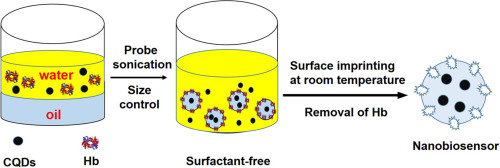Talanta ( IF 5.6 ) Pub Date : 2018-08-10 , DOI: 10.1016/j.talanta.2018.08.030 Tongchang Zhou , Jon Ashley , Xiaotong Feng , Yi Sun

|
A simple fluorescent nanobiosensor based on molecularly imprinted polymers (MIPs) and carbon quantum dots (CQDs) was developed for hemoglobin (Hb) detection. The nanocomposites were synthesized by a novel one-pot surfactant-free Pickering emulsion method, in which imprinted cavities complementary to Hb were formed at the surface of the particles for target recognition, while CQDs were incorporated in the core as the fluorescence probe. We innovatively used the Hb template as emulsifier to help stabilize the emulsion droplets. The method eliminated the need of surfactant, which greatly simplified Pickering emulsion synthesis procedures, and significantly enhanced the fidelity of molecular imprinting. Moreover, the method provided an easy way to integrate fluorescent probes with MIPs in a single step. The nanobiosensor was utilized for determination of Hb via fluorescence quenching, and high selectivity and sensitivity were achieved. Under the optimized conditions, a linear range of 0.77–7.7 nM and a detection limit of 0.77 nM were obtained. The resulting nanocomposites were also successfully applied to detect Hb in the serum samples, which showed good recoveries ranging from 86.8% to 93.9%.
中文翻译:

使用无表面活性剂Pickering乳液制备的混合分子印迹聚合物/基于碳量子点的纳米生物传感器检测血红蛋白
一个简单的基于分子印迹聚合物(MIP)和碳量子点(CQDs)的荧光纳米生物传感器被开发用于血红蛋白(Hb)检测。通过新型的一锅法无表面活性剂Pickering乳液法合成纳米复合材料,其中在颗粒表面形成与Hb互补的压印腔以识别目标,而将CQD作为荧光探针掺入核心。我们创新地使用Hb模板作为乳化剂,以帮助稳定乳液液滴。该方法消除了对表面活性剂的需求,这大大简化了Pickering乳液的合成程序,并显着提高了分子印迹的保真度。此外,该方法提供了一种简单的方法,可将荧光探针与MIP整合到一个步骤中。利用纳米生物传感器通过荧光猝灭法测定血红蛋白,实现了较高的选择性和灵敏度。在优化的条件下,获得了0.77–7.7 nM的线性范围和0.77 nM的检出限。所得的纳米复合材料还成功地用于检测血清样品中的血红蛋白,其回收率在86.8%至93.9%之间。











































 京公网安备 11010802027423号
京公网安备 11010802027423号